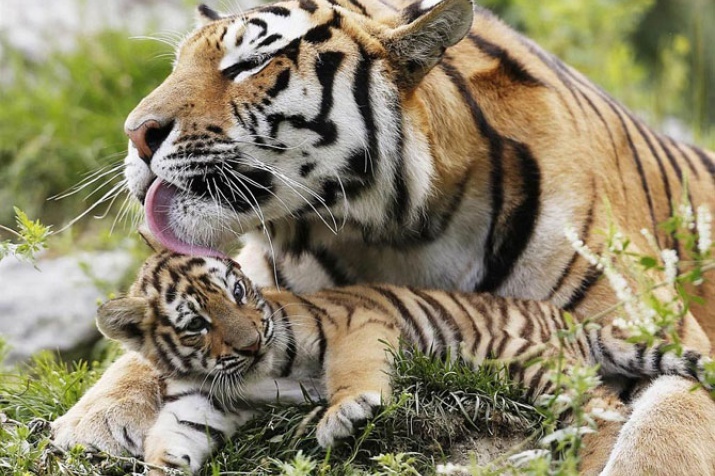About the Siberian tiger
Siberian tiger
Panthera Tigris altaica
Order: Carnivora
Family: Felidae
Genus: Panthera
Conservation Status: Endangered
In 1947 the Siberian tiger was taken under protection and tiger hunting was fully prohibited. The Siberian tiger is enlisted in the IUCN Red List of threatened species, the Red Book of Russia as endangered species and listed in Appendices II of the Convention on International Trade in Endangered Species of Wild Fauna and Flora (CITES).
Where the Siberian tiger lives: 95% of the Siberian tiger world population inhabits the Russian Far-East, 5% of the population lives in China.
Size: Length of the Siberian tiger body, without tail – 160-200 cm, length of tail about 100 cm. Weight of an adult animal can reach 300 kg. The largest weight recorded – 384 kg.
Appearance:
The Siberian tiger is larger than the Bengal tiger; its pelage is thicker and brighter. Reddish body covered with narrow black transverse stripes. Pattern of every tiger is unique, as fingerprints: you won’t find two tigers with identic pattern.
Tigers use black stripes as disguise. Black white spots behind black-colored ears have a different purpose. When a tigress moves along the forest she places her ears in such way so following cubs can see them perfectly.
The winter coat is brighter and thicker. Wide pads help the tiger to move on deep snow.
Behavior and way of life:
Tigers are almost always in motion. They search for prey while patrolling their territory. Like other cats they mark their territory. They also scrape the ground or stand on the back legs and remove the peeling bark from the trees. Sometimes these marks can be found at height of 2-2.5 m from the ground.
Tigers are conservative - they use the same routes for years. They never leave their territory if there’s enough prey within its boundaries.
Habitat area size can vary according to gender, age and number of hoofed animals on the territory. For example, tigress with cubs uses much smaller area for hunting than single animals.
The Siberian tiger has a tremendous physical strength and greatly developed sense organs. Tigers spent a lot of time hunting. Their main prey – hoofed animals. To catch prey tiger creeps upon it, humps the back, sets his rear legs against the ground and attacks. Only one of ten attempts succeeds. If the attempt fails tiger prefers not to follow the prey but to search for a new one. When there’s not enough prey in forests the Siberian tiger can attack cattle and dogs.
Feeding:
Tiger’s diet mainly consists of the Far Eastern red deer, European wild hog and axis deer. Daily food requirement is 9-10 kg of meat. For a well-being one tiger species requires 50-70 hoofed animals annually.
The Siberian tiger not only hunts, but fishes as well. During breeding tigers can catch fish on mountain rivers’ riffles.
Reproduction:
Siberian tigers are considered to be polygamous. Reproduction periods and birth giving are not confined to certain season. Nevertheless, the Siberian tigers usually produce offspring in April – June.
After three to four months of waiting tigress gives birth to two or three blind cubs. Mother tries to arrange a den for cubs in most safe and hard to reach places where they will be hidden from other predators - in thickset forests, caves, splits in rocks.
Cubs open their eyes on the ninth day and their teeth start to grow at the age of two weeks. Tigress feeds her cubs with milk until the age of 6 months. At the age of two months cubs start to find out how the meat tastes like.
Cubs play a lot and acquire hunting skills. Starting from the age of six months cubs follow their mother during hunting and perceive tricks of searching and procuring food. At the age of one year cubs try to apply their skills for the first time. But first attempts often fail. They will be able to get their first large prey only by the age of 2 years old.
Cubs spend first years of their live with their mother. Tigress hunts with young tigers until they hit puberty. On a second year young tigers separate from their mother but continue to live on her territory.
Lifespan:
Lifespan of the Siberian tiger is 16-18 years (up to 25 years in captivity).
Interesting facts:
Siberian tiger is a largest tiger in the world and the most northern tiger population.
Siberian tiger has the thickest and the longest fur. It has fewer stripes than other subspecies. Total number of stripes can reach 100.
Tiger species are currently preserved at 14 countries – Bangladesh, Bhutan, Vietnam, India, Indonesia, Cambodia, China, DPRK, Laos, Malaysia, Myanmar, Nepal, Russia and Thailand.
Tiger population has fallen by 25 times over past 100 years.

